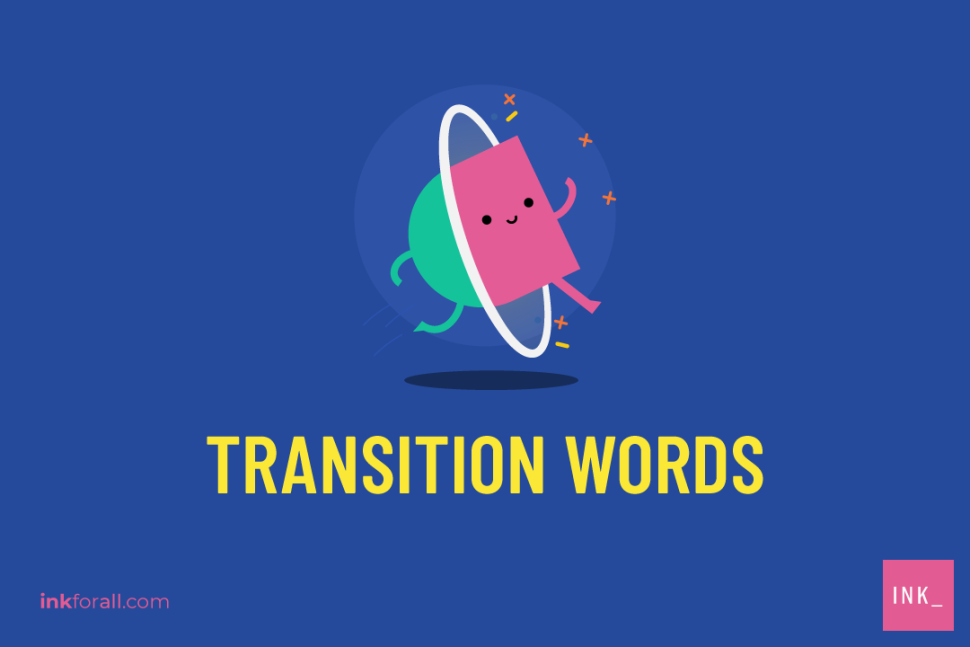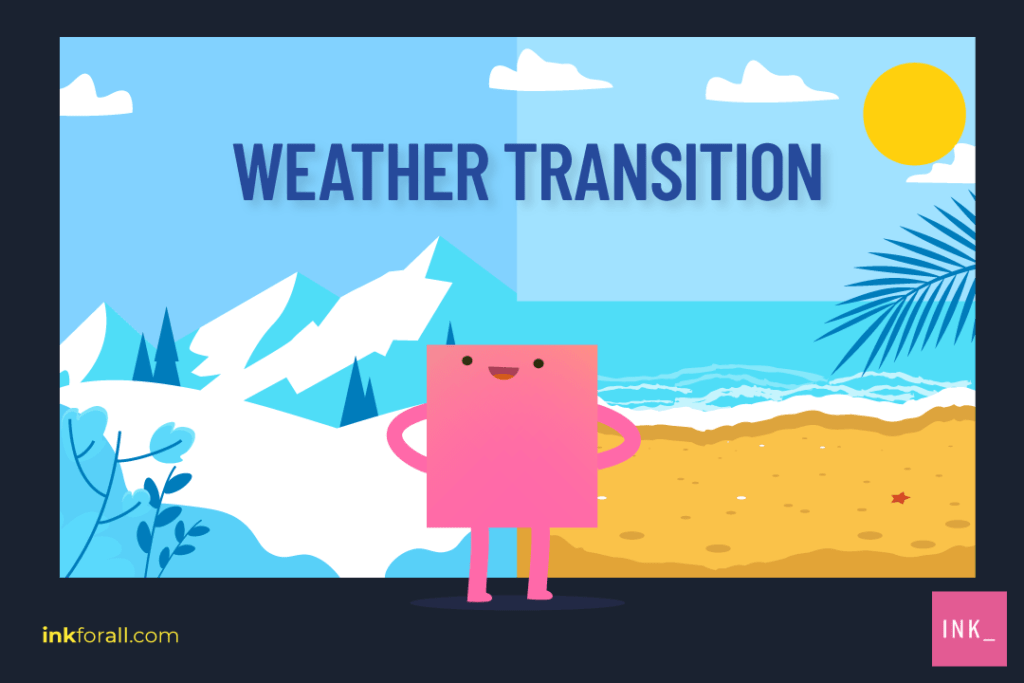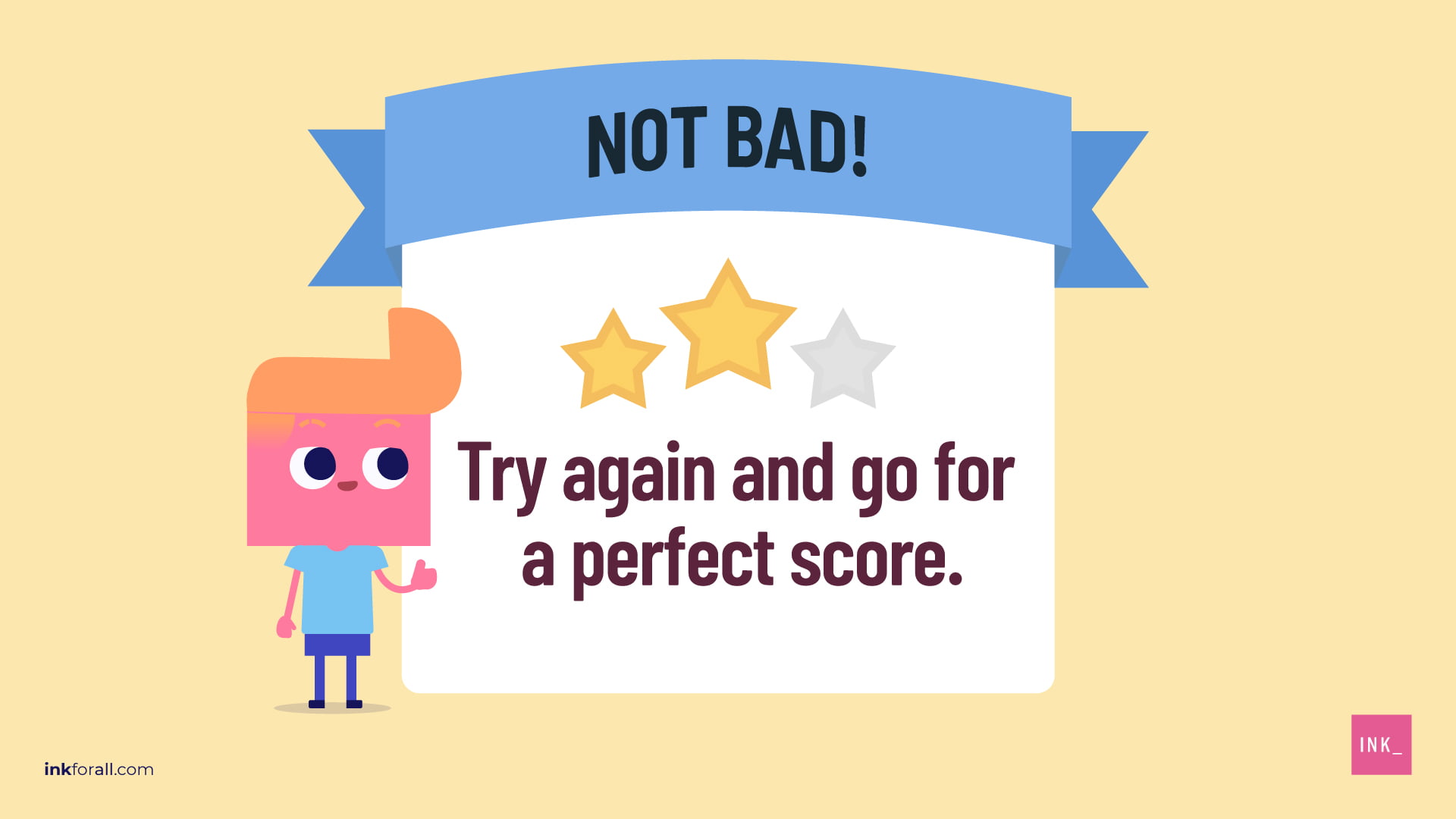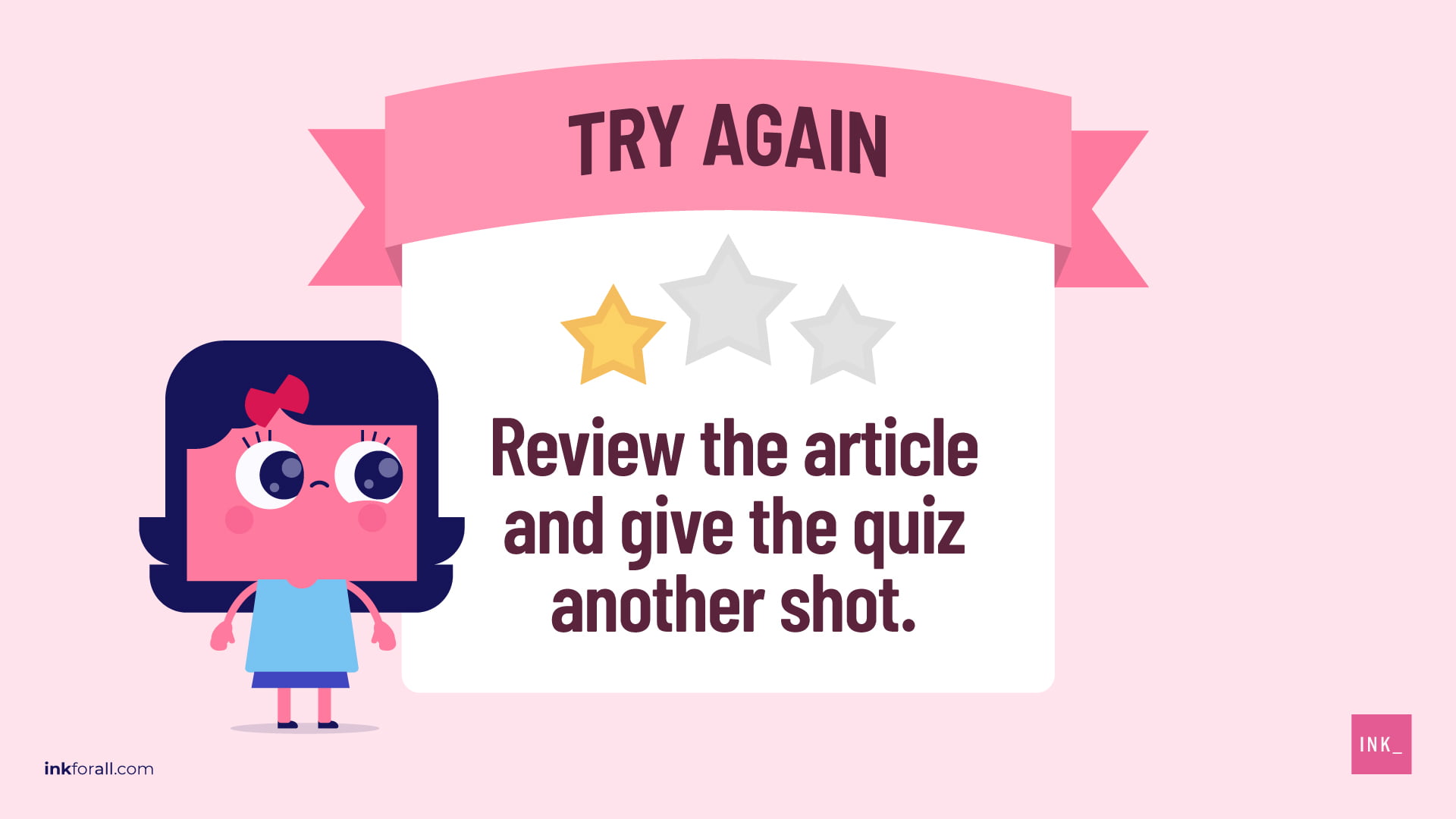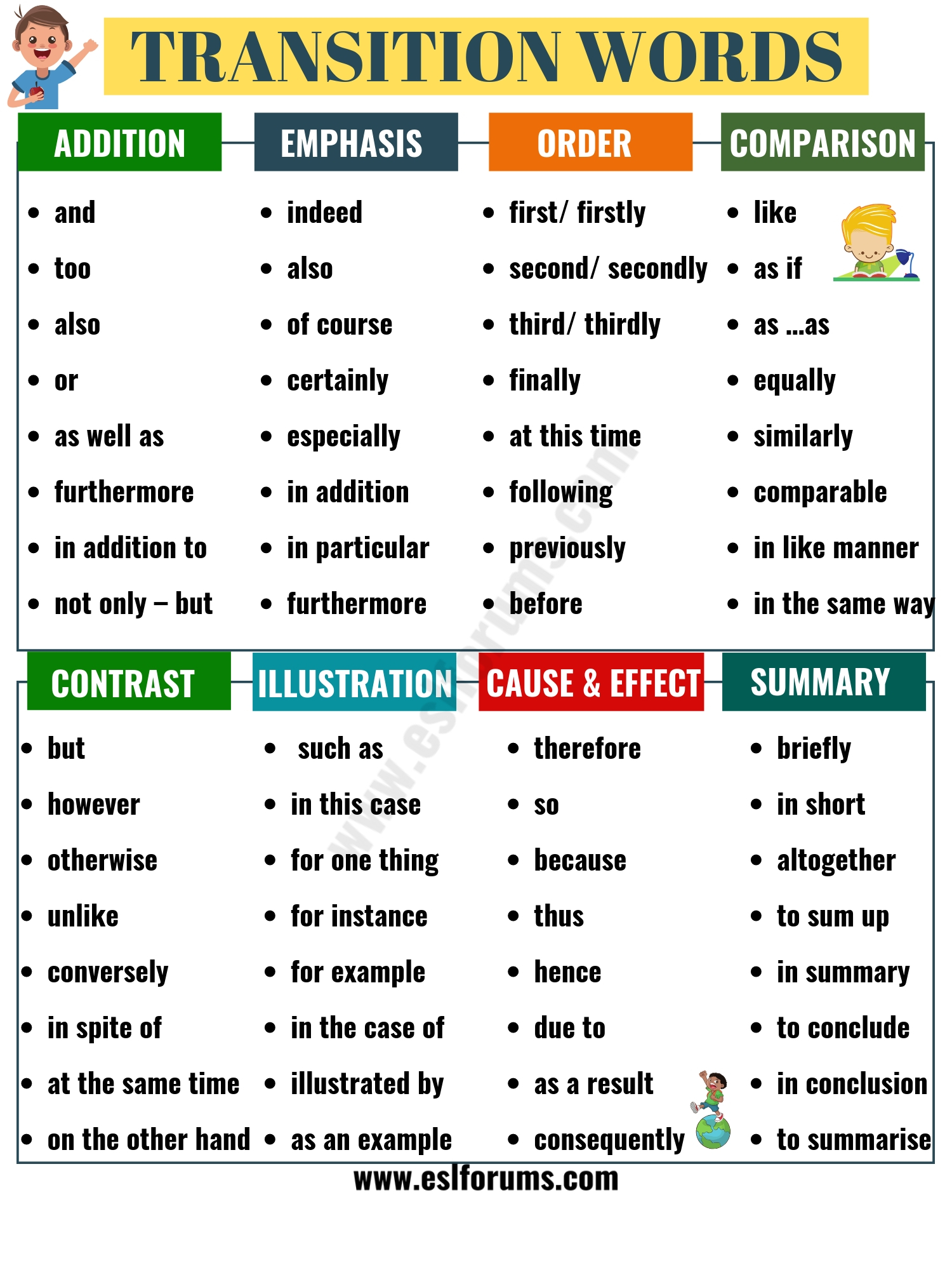Transition words and phrases are a type of vocabulary used to link clauses, sentences and paragraphs as we speak or write.
We use them all the time in English, often without realizing. But since transition words can be the key to clear and concise writing that is easy for the reader to follow, it pays to use them intentionally.
This is especially true in more formal contexts like essays, academic papers, debates and presentations.
So, let’s take a look at some of the different types of transition word you might use in English, and learn how to use them correctly.
What are transition words?
Transition words are used in language to link ideas, signal changes in topic, and bring structure, flow and cohesion. We use them in speaking and in writing, formally and informally.
Other terms for ‘transition words’ include:
- Discourse markers
- Signal words
- Filler words
- Transitional phrases
- Linking words
- Connecting words
- Clue words
- Sentence connectors
When do we use transition words?
There are many ways to categorize and group transition words, but most fall into one of the following categories:
Stating time order; sequencing
When giving a description of events, words like ‘first’, ‘next’ and ‘finally’ help us to lay out the order in which things happened.
We can also use adverbial words and phrases like ‘all of a sudden’, ‘immediately’, ‘sooner or later’ and ‘eventually’ to describe the manner in which things occur.
There are over 100 time transition words for you to explore here.
Comparing and contrasting; stating similarities
Ever had to write a compare and contrast essay? These phrases will have come in handy. Transition words for comparing and contrasting help us to explain how things are different, and to examine alternatives.
Words and phrases like ‘although’, ‘on the plus side’, ‘in spite of’ and ‘by comparison’ all come into this category.
Similarity transition words, on the other hand, help us describe how things are similar or the same.
‘Similarly’, ‘likewise’ and ‘equally’ are all examples of these.
Addition; expansion of a point
One of the first English transition words you ever learned, ‘and’, is an example of a word used to signal addition.
Less common addition words and phrases include ‘furthermore’, ‘coupled with’, ‘not to mention’ and ‘additionally’.
These can also be used to express agreement or to reinforce an idea that has already been stated. They can be very helpful when you are building up an argument in an essay or presentation.
Giving examples
Sometimes you need to give examples to illustrate a point or expand on what you are saying. In this case, you can introduce your example with phrases like ‘for instance’, ‘such as’, ‘as can be seen’ and ‘in this case’.
Clarification
When you need to clarify a point, you might try to state it differently or more concisely.
You can use transition words like ‘to clarify’, ‘to be clear’, ‘that is to say’ and ‘in other words’ to signal that you are simply trying to add clarity.
Emphasis
There are many ways to emphasize a point. We may alter our tone of voice when speaking or use bold or italics in writing. But in both cases, discourse markers can also help achieve this.
There are many adverbs, in particular, that we can use to add emphasis. These include:
- Particularly
- Especially
- Surprisingly
- Certainly
- Markedly
- Significantly
There are also phrases we can use to add emphasis or draw attention to something, such as ‘of particular importance’, ‘as a matter of fact’, ‘with this in mind’ and ‘not forgetting that’.
Stating cause and effect; conditions and results
When forming a logical argument, you must be able to link ideas and demonstrate how one thing affects the outcome of another.
Transition words and phrases to talk about cause and effect include ‘because’, ‘so’, ‘accordingly’, ‘for the purpose of’ and ‘consequently’.
We can also form conditional cause and effect statements using words and phrases like ‘provided that’, ‘only if’, ‘on the condition that’ and ‘in the event of’.
What’s the difference between affect and effect?
Concluding and summarizing
Finally, we can use transition words to summarize our ideas or argument and conclude an essay, presentation or article.
Examples of signal words for conclusions include ‘to wrap up’, ‘in short’, ‘given these points’ and ‘on balance’.
Learn about the difference between summarizing and concluding, and some good transition words for conclusion.
How to use transitional words
When you first learn English, you’ll be introduced to simple transition words like ‘and’, ‘but’ and ‘so’ (also called conjunctions).
These are ideal for forming simple sentences with two or more clauses, but they won’t get you far when writing an essay, making a formal speech, or proposing an idea at a business meeting.
In these scenarios, it’s important to not only know which discourse markers to use, but also how to use them correctly in a sentence. If you click on any of the links above, you’ll find that we have individual pages about each type of transition word which give a lot more examples and – just as importantly – sentences demonstrating how to use them.
You should pay special attention to your punctuation when using these phrases too, so that the placement of the connector itself doesn’t disrupt the flow of your writing.
And finally, avoid overuse. Transitional words should enhance the flow of your speaking or writing but not get in the way of what you actually want to say. When used too often they can make you sound unnatural or overly formal, so carefully consider the placement of each one. The same general rule applies to idioms.
For an important piece of writing, you can always have someone else read through it or get it professionally proofread to ensure it sounds as good as you intended.
Do you want to be more confident using English? Why not try Grammarly’s free proofreading tool. It checks as you write and helps you correct and improve your spelling and grammar.
Do you know the Brooklyn Bridge? Now, imagine the time before it was built—like before 1883.
Obviously I wasn’t there, but I can imagine that it was a struggle for someone to move across the East River between Brooklyn and Manhattan.
Well… you could still get across but not as conveniently as using the bridge—well, maybe they used boats or built small rafts. Not convenient, right?
Bottom line? They needed that bridge.
Likewise, if you want your writing to flow coherently and have the lucidity that makes it easily readable, you NEED transition words.
It’s that STRAIGHTFORWARD.
So what are these bridges? Transition words are words or phrases that connect sentences and paragraphs seamlessly and smoothen out any abrupt jumps or breaks between the sentences.
These words include ‘since to demonstrate’, ‘specifically’, ‘for instance’, ‘and’, ‘but’, ‘so’, and many others. These words are deliberately inserted into the text to show the relationship between phrases, sentences, or paragraphs. They are like soft-footed tour guides for your readers, helping them grasp your thoughts and where your ideas lead to.
On a basic level, we usually use conjunctions (“and,” “but” and “or”) as transition words, for example:
- They wanted to learn fast, and they completed the course with a quarter of the semester to spare.
- They wanted to learn fast, but they barely finished one module after the first month.
You can see that in the examples I gave above, the coordinating conjunctions were employed to indicate two different transitions.
- In the first case, “and” has been used to indicate a transition that connects two occurrences which were harmonized.
- The second sentence employed the conjunction “but” to introduce a contrast.
Just as illustrated in these examples, there are different categories of transition words that we use to get a point across.
Adverb as Transition Words
Apart from the conjunctions, adverbs are also transition words. Adverbs are words that describe the manner in which an action is performed or how two actions relate to each other.
These are examples of how we use them as transition words:
- He did quite an excellent job. Nonetheless, the client seemed a bit dissatisfied with the work.
- We don’t want another costly overseas trip; besides, we can’t afford it.
Can A Transition Be a Question?
Yes, but not necessarily.
Such a simple but somewhat confusing answer. It’s not a grammar rule but an observation that I have made.
As a rule of thumb (which I picked from a very good English tutor), I don’t put a comma after “but” when I use it instead of a conjunctive adverb (e.g., however, nevertheless).
So, if I start a sentence with a “but” and proceed with a question without “pausing”, it means that I have a transition that’s also a question.
For example:
Paragraph 1: The Corporation suddenly sold their stock in the rising company.
Paragraph 2: But how do you sell stock when the expectations are that the company is about to become more valuable?
Obviously my transition word, “but,” is not a question on its own, but the whole sentence is. Therefore, the sentence as a transition from paragraph “1” to “2” is a question.
But as I said, I’m yet to come across a general rule for this type of scenario.
What Are Some Examples of Transition Words?
There are just numerous examples of transition words. However, these words are used to perform different tasks—some are used to show turns and twists, others are employed to indicate similarity, etc.
Basically, we have categories of transition words (based on the type of transition the words represent when they launch a sentence).
These are categories:
Cause/Effect
- We lost. Therefore, we couldn’t proceed to the next round.
- He left Because he was worried about the health of his mother.
Others:
since, on account of, for that reason, consequently, accordingly, thus, hence, as a result.
Comparison/Contrast
- I’d have loved to go, but I have some urgent business here.
- On the contrary, they believed that he was a fool.
- Likewise, the driver of the white van left the boxes on his door.
Others:
Yet, and yet, nonetheless, at the same time, after all, In the same way, by the same token, in like manner, likewise, in similar, but, however, though, otherwise, on the contrary, in contrast, notwithstanding, nevertheless, similarly, on the other hand,
Examples
- Specifically, Jane likes blue shoes.
- To demonstrate its might, the empire wants to impose sanctions on its tiny neighbor.
Others:
for example, to illustrate, for instance, as an illustration, e.g. (for example).
Clarification
- In other words, he wants you to go.
- To put it another way, your company doesn’t need any more liabilities.
Others:
to clarify, to explain, that is to say, i.e. (that is), to rephrase it.
Qualification
- This is possibly the best score in ten years.
- With this in mind, the board declared him the best investment banker of that year.
Others:
Probably, always, nearly, never, maybe, frequently, perhaps, although.
Addition
- Moreover, I wanted to go hiking with her friends.
- Furthermore, the higher you go, the harder it becomes to climb down.
Others:
in addition, even more, too, also, last, lastly, finally, in the second place, again, next, further, besides, and, or, nor, first, second, secondly.
Summary/Conclusion
- Given these points, it is very apparent that she is knowledgeable about what is going on.
- In the long run, everyone will earn huge dividends from their investment.
Others:
In conclusion, to sum up, to summarize, in sum, in brief, in short, in summary, to conclude, finally.
Chronology/Time
- He wrote her a note Before left for Italy.
- During the event, you could hear them chant war cries.
- Later that evening, he arrived with a big entourage.
Others:
While, now, immediately, following, never, after, earlier, always, when, whenever, meanwhile, soon, sometimes, afterwards, until now, next, once, then, at length, simultaneously, so far, this time, subsequently, in the meantime.
Emphasis
You have to have a hard-working attitude and self-belief. Above all, you have to put all your trust in God.
Others:
Above all, most importantly, certainly.
When to Use a Transition Word
To Glue a Single Sentence
Transition words are used to link parts of the same sentence.
Here are some examples:
- The boss acts as if the employees are just little kids under his supervision.
- He prefers to go by himself rather than send someone else in his place.
- The company did not adopt his proposed marketing strategy, yet if they had savvy executives, they would have realized how innovative and profitable his plans were.
To Start a Paragraph
Before choosing a transition word or phrase, always think about the cohesiveness—between the current paragraph and the one that precedes it—the transition will bring. Are the two paragraphs carrying comparing and contrasting ideas? Are you trying to describe events in chronological order?
When we use transitions to introduce a new paragraph, they are usually phrases or clauses which refer to the preceding paragraph while launching a new idea.
The transitions that we often used at the beginning of new paragraphs may be phrases like these:
- It follows logically that entity A and B cannot be clearly distinguished by dead reckoning.
- Furthermore, the gentleman has confessed his crime and has named his accomplices.
- In conclusion, the theory does hold in reality.
- Lastly, an investigation needs to be launched to find out what really happened here.
Coherence is what your transitions are there to help you with. Therefore, you ought to place a great emphasis on the gluiness of your transitions.
Gluing Paragraphs
Inside your paragraph, transitions have to help you explain the relationships between your ideas. You have to think about what the previous sentence before this one says and how that sentence or phrase relates to the one the transition is trying to introduce.
Do you want to add more information to the preceding sentence? Or, do you want to emphasize the subject succeeding the transition?
When we use transitional words to stitch a paragraph, we often try to make it flow smoothly. In the next example, I have used transition words to stitch together a short paragraph.
A Paragraph Without Transitions: He left his job in Louisiana. His mother was ill. She recovered, he went back to Louisiana.
A Paragraph with Transitions: He left his job in Louisiana because his mother was ill. After she’d recovered, he went back to Louisiana. But, he no longer had a job and had to start from scratch again.
Do Transitions Help in Writing a Story?
Not only do transitions help in writing a story, but they also help you quickly and easily improve your writing. There are plenty of benefits of using transitions.
Firstly, using transitions is a good way of programming yourself to transcend the subaltern practice of using a basic subject-verb sentence structure. With transitions, you have sentences which are more complex but still coherent.
Besides adding to the complexity of your sentences, the stitching factor that transitions bring to your text makes it readable and helps you create passages with a bit more refinement.
Finally, perfectly employed transitions can make your writing sound more professional. Professional writers know that there should be a noticeable difference between written and spoken language (unless it’s dialogue). Transitions give your writing a tinge of that much-needed professionalism, just enough to make it sound better than spoken English.
Signs That You Need to Work On Your Transitions
There are a couple of red flags that pop up whilst writing or when you’re provided with feedback. Here are some of the scenarios that require you to work on your transitions:
- When you submit a manuscript or an academic assignment and you’re bombarded with comments like “this is choppy,” “it’s jumpy,” “the passages aren’t flowing smoothly,” “your writing desperately needs signposts,” or “how are paragraph X and Y related?”
- When you get feedback from your readers, saying they are having a tough time following the structure and flow of your content.
- When you take separate, disjointed chunks of texts and stitch them together without adding adhesive words or phrases.
- When you are working on a group assignment and the draft includes parts written individually by several group members.
How Can I Improve My Use of Transition Words
The fact that everyone uses transition words is quite apparent. But, using them correctly or efficiently isn’t something which every writer does naturally. Using transition words effectively is a result of a couple of things. To successfully use transitions, you have to:
1. Arrange Your Thoughts and Ideas
Remember what I said about transition words acting like bridges linking your paragraphs and sentences together? Well, they are more than that.
They’re also signposts. Before writing a blog post, news article, or a book, one usually has a bunch of incoherent but lucid ideas to work with. Usually, you—the writer—know where your story is going but you need to give the reader some directions.
They have to understand and follow your arguments and you have to clearly define the relationships between different sentences or parts of writing.
Your writing needs to have a firm structure and it’s the effective use of transition words that will help you give the text that structure.
But first, you need to know how your ideas relate to each other. It needs to be clear to you which idea introduces the other, which breaks away from the original points, and so on and so forth. This means that you have an introduction, body, and conclusion.
Afterwards, you can start adding meat to the skeleton, sew the sentences together. Find jumps and breaks that present perfect slots for transitions and make sure the transitions employed make sense.
2. Know the Transition Words
This is usually a problem for non-native speakers. But, many native speakers tend to “underutilize” transition words; they simply don’t pay attention to some less frequently used transitions.
So, whether you’re a native speaker or not, it’s prudent to look up a list of transition words and study their employment. It’s not only a matter of having used the transition word before, sometimes, their usage may depend on context like the “i.e.” vs “e.g.” case which is a grammatical evil that has preyed on a lot of unsuspecting native speakers.
Knowing the words helps you contextualize the transitions.
My Final Words On Transitions
Transition words are essential for the readability of your writing. Unfortunately, a lot of people fail to utilize them effectively. If you are one of these people, don’t worry about it too much. Study them and practice a lot.
Like a lot, A LOT. Always be aware of the way you structure your text. In this way, it will be less of a task trying to choose the best transitions to use.
Transition Words in English! Like other languages, English has a lot of cohesive and transition words that can be used to express addition, contrast, cause and effects, purpose… with examples and ESL printable infographic.
Common Transition Words
Here is the list of frequently used connecting words in English
Expressing Addition
To add information, you can use these expressions:
- Additionally
- Furthermore
- Moreover
- In addition
- Likewise
- Similarly
- Also
- As well as
- Not to mention
- Coupled with
- Together with
- And
- Too
- What is more
- Not only…but also
- Besides
Examples:
- She was an excellent swimmer. Additionally, she was a talented gymnast.
- The movie received critical acclaim. Furthermore, it was a box office success.
- The restaurant has great food. Moreover, the service is exceptional.
- I enjoy hiking. In addition, I love camping in the mountains.
- John loves playing the guitar. Likewise, his brother is also musically talented.
- Sarah and Emily have a lot in common. Similarly, they both enjoy painting and reading.
- I love chocolate cake. Also, I enjoy eating ice cream.
- My sister speaks French fluently. As well as that, she’s learning Spanish.
- The museum has beautiful paintings. Not to mention, the sculptures are also amazing.
- The company offers a great benefits package. Coupled with a competitive salary, it’s a desirable place to work.
- The team worked hard. Together with their coach’s guidance, they won the championship.
- I like to read books. And I also enjoy listening to audiobooks.
- Jane likes to travel. Too bad she can’t go anywhere now due to the pandemic.
Expressing Contrast
To express contrast, you can use these expressions:
- However
- On the other hand
- In contrast
- Nevertheless
- Nonetheless
- Conversely
- But
- While
- Although
- Even though
- Despite
- In spite of
- Whereas
- Unlike
- Rather
- On the contrary
- Alternatively
- Despite this
- Regardless
Examples:
- Brain drain has terrible consequences on the developing countries. Nevertheless, nothing has been done to solve the problem or at least reduce its negative effects.
- In spite of/despite Fred’s old age, he goes jogging every morning.
- Although she’s very nice, her classmates hate her.
- They have got two children, a boy and a girl. The boy takes after his father whereas the girl takes after the mother.
Expressing Cause and Effect
To express cause and effect, you can use these expressions:
- Consequently
- As a result
- Therefore
- Thus
- Accordingly
- Hence
- Because of
- Due to
- Owing to
- For this reason
- So
- Since
- Consequently
- That’s why
- Under these circumstances
- In effect
- In consequence
- In view of this
- So that
- Therefore, it follows that
Examples:
- She remained silent, for she was so depressed to talk.
- We can’t go to Sue’s party because we’ll be busy working on our project.
- The plane was delayed because of the foggy weather.
- He had spent most of his time hanging around instead of revising his lessons. Consequently, he had a lot of trouble answering the exam questions.
Expressing Purpose
To express purpose use the following words:
- To
- In order to
- So as to
- For the purpose of
- With the aim of
- With the intention of
- To the end that
- To this end
- With this in mind
- With a view to
- For the sake of
- In the hope that
- In the interest of
- In order that
- So that
Examples:
- She wakes up early in order to be on time to work.
- They visited him so as to offer their condolences for the death of his wife
- He helped the new policewoman so as not to fail in her first mission.
Summarizing
To summarize, you can use the following expressions:
- In conclusion
- To summarize
- All in all
- Ultimately
- Overall
- To sum up
- To put it briefly
- In summary
- Briefly stated
- To conclude
- In essence
- Given these points
- As a result
- Hence
- Therefore
- Thus
- Consequently
- In brief
- In short
- In a word
Examples:
- In conclusion, I hope the preceding arguments have convinced you of the need for action.
- To conclude, I’d like to express my thanks to my family.
- To sum up, damp walls are not disastrous structurally, but the cause must be ascertained and the condition rectified.
- In a nutshell, the owners thought they knew best.
- In brief, I have made up my mind to quit my job.
List of 100 Transition Words
- Additionally
- Also
- Furthermore
- Moreover
- In addition
- Likewise
- Similarly
- Another
- Equally important
- Correspondingly
- Next
- Then
- Consequently
- Therefore
- Thus
- Hence
- Accordingly
- As a result
- Because
- Due to
- Since
- As a consequence
- For this reason
- In effect
- In fact
- In other words
- That is
- Namely
- To clarify
- To illustrate
- To explain
- For example
- For instance
- Specifically
- In particular
- As an illustration
- Notably
- Significantly
- As a matter of fact
- Certainly
- Indeed
- Surely
- Undoubtedly
- Without a doubt
- Clearly
- Obviously
- Evidently
- Apparently
- In any case
- At any rate
- Anyway
- However
- Nevertheless
- Nonetheless
- In contrast
- On the other hand
- Conversely
- Whereas
- Although
- Even though
- In spite of
- Despite
- Regardless
- Still
- Yet
- But
- All things considered
- All in all
- Altogether
- In summary
- In conclusion
- To summarize
- To conclude
- In brief
- Alternatively
- By the same token
- In the meantime
- Meanwhile
- Subsequently
- Henceforth
- Thereafter
- To sum up
- Ultimately
- Finally
- Eventually
- As soon as
- As long as
- Before
- Afterwards
- At the same time
- Simultaneously
- On top of that
- In comparison
- On the contrary
- In reality
- To emphasize
- To highlight
- To put it differently
- To put it another way
Useful Linking Words | Infographic
Related Links
- Last But Not Least: Definition, Important Rules with Useful Examples
- 40 Common Transition Words – ADDITION in English
Main Transition Words Takeaways:
- Transitional words are important because they help improve the flow between words, phrases, sentences, and paragraphs.
- They are important for SEO because they help make text easier to read and understand. Search engines and readers love content that is readable.
- Transition words help link ideas and statements.
- Using transitional words at the beginning or end of a paragraph can help the reader understand when you introduce a new topic.
- The four types of transition words are additive, adversative, causal, and sequential.
- Transition words and phrases don’t affect the grammatical structure of sentences and paragraphs.
What Are Transition Words?
As a writer, your primary goal is to present information and ideas to your target audience in a clear and understandable manner. The best way to do that is to use transition words. Transition words or transitional words are terms and phrases that help connect words, phrases, and even sentences together. They build connections between ideas in your content.
Transition words and phrases ensure that your written work will not look choppy and disjointed. They help your audience progress from one idea to the next. Think of them as a way to tell your readers how they should process and understand the information you are giving them. Transition words function like GPS, guiding your readers where they are going and how to get there.
What Are Some Examples Of Transition Words and Phrases?
Here are some of the most common examples of transition words and phrases:
Not to mention
Equally important
As a matter of fact
Not only/But Also
In addition
In fact
For example
What is more
In particular
On the other hand
When in fact
But even so
Whatever happens
In any case
Because of
Due to
In the event that
With this in mind
To conclude
By the way
To return to the subject
As has been mentioned
Given these points
Transition words are categorized based on their purpose. For instance, transition phrases like as a result of, due to, and as long as are used to emphasize cause and effect. Below are more examples of transition expressions that have been categorized based on their functions:
Cause and Effect
granted that
as long as
for the purpose of
in order to
in view of
as a result of
due to
because
therefore
consequently
so
accordingly
thus
hence
Since
for
owing to
as a consequence of
leads to
contributes of
stems from
comes from
results from
Evidence
as well as
and
too
also
in addition to
or
not only… but also
further
furthermore
besides
in addition
moreover
then
again
finally
by the same token
identically
uniquely
certainly
truly
including
to be sure
namely
chiefly
Contrast
however
on the other hand
otherwise
but
unlike
conversely
in spite of
at the same time
nevertheless
alternatively
on the contrary
yet
whereas
apart from
even so
although
while
Comparison
as
as if
similarly
equally
like
in the same way
comparable
as with
of contrast
despite this
in comparison
in contrast
even though
likewise
in like manner
Opinion
I feel
I believe
in my opinion
as fast as I know
in my experience
as for me, I think
if I’m not mistaken
I think
in my view
it seems likely
it seems to me
what I mean is
i’d say that
Similarity
moreover
as well as
together
of course
likewise
comparatively
correspondingly
similarly
furthermore
additionally
Clarification
that is to say
in other words
to clarify
that is
to explain
to put it another way
to rephrase it
in this case
I mean
up to a point
under certain circumstance
Sequence/ Order
first
second
next
finally
at this time
following
previously
before
prior to
before
Time
later
after
before
soon
meanwhile
during
subsequently
after that
at the present time
sooner or later
in due time
as long as
in the meantime
in a moment
at this instant
from time to time
Condition / Purpose
provided that
given that
in case
even if
only if
so as to
in as much as
when
whenever
if… then
unless
because of
as
while
lest
since
Emphasis
also
especially
furthermore
indeed
in addition
in particular
certainly
of course
significantly
notably
in fact
actually
in reality
as it happens
Conclusion
in conclusion
to conclude
finally
summarizing
overall
on the whole
to sum up
evidently
briefly
in short
altogether
in summary
to summarize
Place
here
there
over there
under
beyond
to the left
opposite
in the distance
Illustration
such as
in this case
for one thing
for example
in the case of
illustrated by
as an example
for instance
in other words
as revealed by
an instance
to show that
Reservation
admittedly
even so
as a matter of fact
indeed
nevertheless
even though
despite this
notwithstanding
regardless
What Are Some Examples of Transition Sentences?
The best way to understand how transitional words work is to see them in action. Remember, as important as these grammatical tools are, it’s not a good idea to overuse them. Too many transitional phrases can make your text seem complicated and wordy. It could also make you seem like a chronic overexplainer, and nobody wins when that happens.
You can use transitions to go from sentence to sentence:
You can also use transition words and phrases to go from paragraph to paragraph:
What Are the Four Types of Transition Words?
There are a lot of different ways to categorize transition words. In this post, we will discuss the four main types of transition words: Additive, Adversative, Causal, and Sequential.
1. What are Additive Transitions?
These transition words add or introduce another idea. They may also reference a previously mentioned concept, identify a similarity, or clarify an idea. Additive transitional words include:
2. What are Adversative Transitions?
Adversative transitions may be used to signal opposing ideas or dismiss a previously discussed idea altogether. Some adversative transition words include:
3. What are Causal Transitions?
As for causal transitions, they’re most commonly used to denote cause and effect. They may also indicate the reason an idea or action is happening or has happened. Causal transition words include:
4. What are Sequential Transitions?
As the name suggests, sequential transitions are used to put a sequence of ideas in order (usually chronological). This helps the reader understand where ideas fall in a list or when you’re wrapping up your text. Sequential transitions include:
Are Conjunctions Considered Transition Words?
While conjunctions and transitions share the same purpose — to connect ideas between or within sentences — they are not used the same way. You must not confuse conjunctions with transitional words or expressions. Conjunctions connect phrases and clauses, whereas transitions indicate the relationship between sentences and paragraphs. Check the following examples:
Subordinating conjunctions connecting dependent clauses with independent clauses:
Read More: The Easiest Way To Get Subordinating Conjunctions
Coordinating conjunctions connecting two independent clauses:
Transition words connecting sentences and paragraphs:
Another significant difference between transitions and conjunctions is their grammatical functions. Since conjunctions join clauses, they become part of the sentence and affect it grammatically. On the other hand, transition words have no impact on the grammatical structure of a sentence or paragraph. In short, you can remove a transition word, and it won’t have any impact on the sentence at all. Check the examples below:
Do Commas Go Before Or After Transition Words?
The placement of commas when using transition words will depend on where the latter appears in your text.
If your transition phrase appears at the beginning of the sentence, it is always set off with a comma.
If the transition word or phrase appears within an independent clause, it should be preceded by and set off with a comma.
If the transitional word appears between two independent clauses in a compound sentence, it should be preceded by a semicolon and set off with a comma.
How Are Transition Words Used in SEO?
SEO, or search engine optimization, is a process that involves optimizing your content for search engines to help improve ranking. The higher you are in search results, the more visibility your content will have. The more visible your content, the more people will see and learn about your brand.
Unlike keywords or meta tags, transitions between sentences or paragraphs don’t directly help boost your search ranking. Instead, it’s all about readability and structure.
See, Google runs on algorithms and those algorithms are big fans of order and ease of use. In other words, clarity is everything.
In the olden days (you know, like the 2010s), Google was like a heat-seeking missile for keywords. Basically, the more keywords you could stuff in your copy, the better you’d rank. That led to a lot of web pages that said something like, “buckets buckets buy some buckets buckets for sale the best buckets.”
What are they selling? You guessed it: buckets!
Google (and the rest of the world) soon realized the keyword stuffing wasn’t really good for anyone. Instead, search engines began focusing on how web pages could best serve the reader. Now, algorithms analyze web content for readability, and transition words play a huge role in that determination.
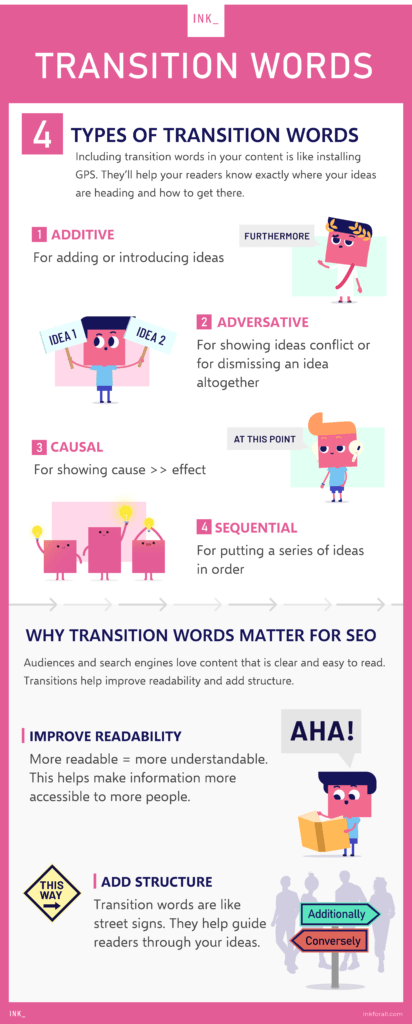
Transition Words Give Direction
Transition words also help you structure your content. Remember our road map? Transitional words can act as street signs, pointing readers left or right, directing them to take a U-turn, or propelling them onward.
Bottom line: Transition words make your content easier to read and understand. For this reason, it’s vital to rely not only on helpful tools but also on your own mind. If it reads well to you, it’ll likely read well to your audience.
Transition To a Closing
Finally, you can use transitions to introduce a new section or conclude your previous one—or wrap up the entire text. You may even use a transition to reinforce the general idea of your content before ending your piece:
Quick Transition Words Grammar Quiz
Transition Words Question #1
A. Causal
B. Additive
C. Adversative
D. Sequential
Correct!
Wrong!
The correct answer is letter C. Adversative transition words may be used to signal opposing ideas or dismiss a previously discussed idea altogether.
(E.g., but, however, conversely, still, and besides)
Causal Transition Question #2
A. Additionally
B. Consequently
C. Either way
D. To illustrate
Correct!
Wrong!
The correct answer is letter B. Consequently along with words like for, since, unless, as a result, and hence are all causal transition words.
(E.g., «Flexible workers often find themselves in great demand, and consequently, earn high wages.»)
Transition Words in SEO Question #3
A. They make content more interesting.
B. They make content easier to read.
C. They help increase word count.
D. Trick question! They’re not important for SEO at all.
Correct!
Wrong!
The correct answer is letter B. Transition words help improve the flow of ideas within a piece of content, making it more readable and easy to understand. Content with a high readability score can boost your SEO.
Transition Words Quiz Result
You’re an expert!
Not Bad!
Almost got it! Review the article and try again.
Read More: How to use a question mark (?)
As a “part of speech” transition words are used to link words, phrases or sentences. They help the reader to progress from one idea (expressed by the author) to the next idea. Thus, they help to build up coherent relationships within the text. In this lesson, you will learn a list of useful transition words and phrases in English.
Transition Words of Addition
List of transition words of addition.
- As well as
- And
- Too
- Furthermore
- Also
- In addition to
- Not only – but also
- Or
- And
- In addition to
- Furthermore
- Moreover
- Besides
- Than
- Too
- Also
- Both-and
- Another
- Equally important
- First
- Second
- Again
- Further
- As well as
- In the second place
- Next, likewise
- Similarly
- For example
- For instance
- However
Transition words of addition with examples
- As well as
He plays classical music, as well as pop and jazz.
- And
There is no paradise on earth equal to the union of love and innocence
- Too
‘Nice to talk to you.’–‘Nice to talk to you too.’.
- Furthermore
He is lazy, and furthermore, he has no sense of responsibility.
- Also
The rehearsal process also irked him increasingly.
- In addition to
The film star has an incredible car in addition to a large house.
- Not only – but also
We do not only meet to share each other’s burdens but also to partake in each other’s joys.
- Or
Music has charms to soothe a savage breast, to soften rocks or bend a knotted oak.
Transition Words of Illustration
List of transition words of illustration.
- Thus
- For example
- For instance
- Namely
- To illustrate
- In other words
- In particular
- Specifically
- Such as
- In this case
- For one thing
- In the case of
- Illustrated by
Transition words of illustration with examples.
- Such as
America wants to eliminate tariffs on items such as electronics.
- In this case
In this case, several solutions could be tried.
- For one thing
For one thing, intelligence does have some impact on foreign policy, for example, towards rogue states.
- For instance
Murder, petty theft and tax evasion, for instance, all have different motives and consequences.
- For example
There is a similar word in many languages, for example in French and Italian.
- In the case of
In the case of the car industry, in the case of Ford, it’s even higher.
- Illustrated by
The difference is best illustrated by a case example.
- As an example
It is given only as an example which is easy to state.
Transition Words of Cause and Effect
List of cause and effect transition words.
- Consequently
- Therefore
- So
- Because
- Thus
- Hence
- Due to
- As a result
Cause and effect transition words with examples.
- Therefore
He has broken his leg and therefore he can’t walk.
- So
Places are strictly limited, so you should apply as soon as possible.
- Because
Because friendships enhance our lives, it is important to cultivate them.
- Thus
He didn’t work hard. Thus he was fired.
- Hence
Cocaine production requires large amounts of water, hence factories are nearly always built by streams.
- Due to
The country economic problems are largely due to the weakness of the recovery.
- As a result
As a result, he went bankrupt soon.
- Consequently
My car broke down and consequently I was late.
Transition Words of Comparison
List of comparison transition words.
- Similarly
- Likewise
- In like fashion
- In like manner
- Analogous to
- As …as
- As if
- Equally
- Similarly
- Like
- In the same way
Comparison transition words with examples
- As …as
He is as tall as his brother.
- As if
Since his cancer was diagnosed, he feels as if he’s living on borrowed time.
- Equally
False humility and its obverse, arrogance, are equally unpleasant.
- Similarly
Similarly, Fire Support Company had to set up their display of mortars, anti-tank missiles and Scimitar tracked recce vehicles.
- Like
Benefits please like flowers, while they are fresh
- In the same way
We like them in the same way that we like pretty curtain material.
- Comparable
Its brain is closely comparable to the brain of a chimpanzee.
- In like manner
And in like manner buyers will fence, and pretend to be less eager than they really are.
Transition Words of Contrast
List of contrast transition words
- On the contrary
- Contrarily
- Notwithstanding
- But
- However
- Nevertheless
- In spite of
- In contrast
- Yet
- On the one hand
- On the other hand
- Rather
- Or
- Nor
- Conversely
- At the same time
- While this may be true
Contrast transition words with examples
- But
Weak men wait for opportunity, but the strong men make it.
- However
The ant is the most industrious animal; however, it is the most taciturn one.
- On the other hand
I want to go to the party, on the other hand, I ought to be studying.
- Otherwise
Shut the window, otherwise, it’ll get too cold in here.
- Unlike
Dan’s actually quite nice, unlike his father.
- Conversely
In real life, nobody was all bad, nor, conversely, all good.
- At the same time
I was afraid of her, but at the same time, I really liked her.
- In spite of
In spite of my efforts, the boy remained passive.
Transition Words of Emphasis
List of transition words of emphasis
- Above all
- Indeed
- Truly
- Of course
- Certainly
- Surely
- In fact
- Really
- In truth
- Again
- Besides
- Also
- Furthermore
- In addition
Transition words of emphasis with examples
- Especially
Divorce is very painful, especially when children are concerned.
- Also
The study also demonstrated a direct link between obesity and mortality.
- In particular
The military, in particular, were subjected to intense political indoctrination.
- Furthermore
He is old and unpopular. Furthermore, he has at best only two years of political life ahead of him.
- In addition
The company provides cheap Internet access. In addition, it makes shareware freely available.
- Indeed
This was indeed the most memorable day of my life.
- Of course
In any of these discussions, of course, honesty is of the essence.
- Certainly
There certainly wasn’t any malice in her comments.
Transition Words of Order
List of transition words of order
- First/ firstly
- Second/ secondly
- Third/ thirdly
- Finally
- At that time
- Previously
- Before
List of transition words of order with examples
- First/ firstly
Firstly, they must make certain that their pension needs are adequately catered for.
- Second/ secondly
Firstly, it’s expensive, and secondly, it’s too slow.
- Third/ thirdly
Thirdly, they tend to see human behaviour as shaped by the system.
- Finally
I kept at it and finally finished at 3 o’clock in the morning
- At that time
At that time, it was completely unheard-of for girls to go to university.
- Previously
A number of trades, previously thought of as lowly ones, began to receive more attention.
- Before
He snatched the photos out of my hand before I had a chance to look at them.
Transition Words of Summary/ Conclusion
List of transition words of conclusion
- In conclusion
- To summarise
- Altogether
- In short
- To sum up
- Briefly
- To conclude
- Therefore
- Finally
- Consequently
- Thus
- In short
- In conclusion
- In brief
- As a result
- Accordingly
Transition words of conclusion with examples
- In conclusion
In conclusion, walking is a cheap, safe, enjoyable, and readily available form of exercise.
- To summarise
To summarise, this is a clever approach to a common problem.
- Altogether
Altogether, our achievements are very great.
- In short
Try tennis, badminton or windsurfing. In short, anything challenging.
- To sum up
Well, to sum up, what is the message that you are trying to get across?
- In summary
In summary, all government departments are administered rather differently.
- Briefly
Briefly, the hunter and his quarry glared at each other.
- To conclude
To conclude, I’d like to express my thanks to my family.
Transition Words of Time & Sequence
List of transition words of time & sequence
- Later
- After
- Before
- Then
- Soon
- Finally
- First, second…
List of transition words of time & sequence with examples
- Later
Later, it transpired she had failed the examination.
- After
It is not enough to help the feeble up but to support him after.
- Before
Before you give up, think of the reason why you held on so long.
- Then
If you doubt yourself, then indeed you stand on shaky11 ground.
- Soon
Always taking out the meal-tub, and never putting in, soon comes to the bottom.
- Finally
Finally, he returned to the official line from which he had swerved.
- First, second…
First, catch your hare then cook him.
Transition Words of Direction & Place
List of transition words of direction & place
- Here
- Over there
- Beyond
- Under
- To the left
- In the distance
- Opposite
List of transition words of direction & place with examples
- Here is a summary of the news/a news summary.
- Are they friends of yours, over there?







